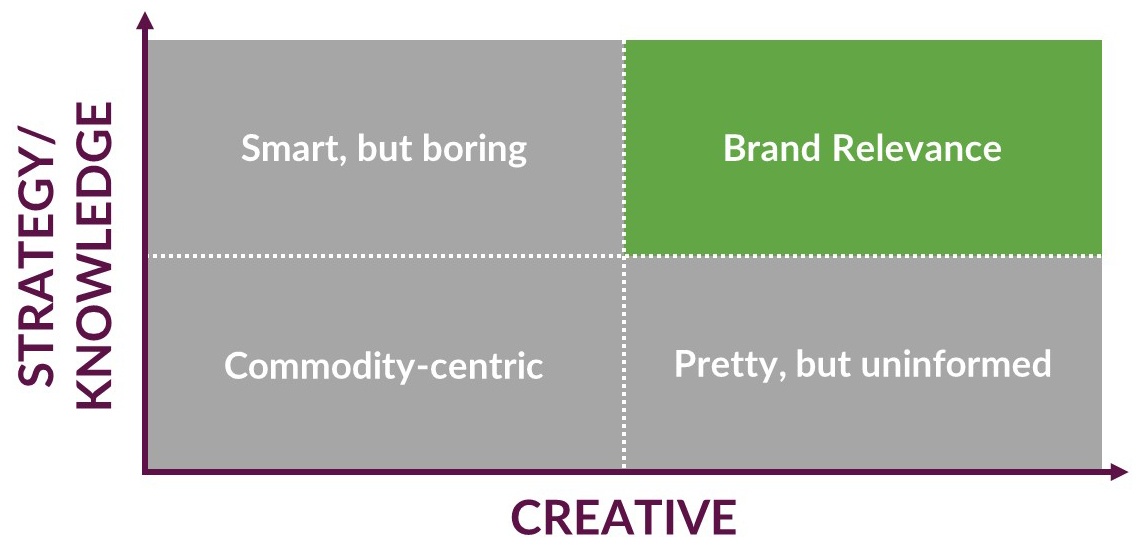The quest for brand status can involve quite the balancing act for marketers: should the focus be on the creative or on developing strategy that will deliver solid results? To make things more complicated, improving each of those aspects takes time—and time is arguably the scarcest of our resources in this industry. While it’s important to present visual concepts that are appealing and evocative, it’s also non-negotiable that each piece of marketing strategy be logically based on solid data (or at the very least, an educated guess based on prior knowledge and experience). So in short, the answer is BOTH!
As for the DMA Solutions team, we address that conundrum by using the following matrix (a Dan’l brainchild, which will be no surprise to most of you!) as a lens through which we view our marketing efforts:

The way we see it, fresh produce marketing most often falls into one of the following four categories:
Smart But Boring Marketing
Now, I’m one of those people who thoroughly enjoys hard data. I have a scientific research background, and I quite appreciate the (subtle) beauty of the quantitative analysis (looking at you, regression model!). But let’s face it: we’ve all seen examples of marketing efforts that, while built on a solid knowledge base, are just plain boring. Especially if you aren’t speaking in “layman’s terms,” don’t expect to reach consumers—or even a trade audience—if you aren’t integrating visual elements to engage viewers.
Pretty But Uninformed Marketing
[Editor’s note: Dwayne Johnson, if you’re reading this, we at DMA think you are a very smart man, and we are not responsible for the above .gif!)
On the flip side: flashy creative is great, but at the end of the day…what are you going to do with it? How are you going to put that stellar animation to good use (and…you know, does it actually make sense? Does it tell a story?), and most importantly, how do you know you’ll be getting solid results with your strategy?
If none of the strategic groundwork is in place to promote your efforts to the intended audience, what use is exemplary creative, really?
Commodity-Centric Marketing
And here we have the worst of both worlds: fresh produce marketing that is neither appealing nor strategically sound. Even as marketing continues to progress in fresh produce, the fact remains that there are companies that will continue to embrace commodity status and exist as transactional entities. This type of company’s minimal marketing efforts could appear as:
- Lack of company story—identity is relegated to a name and dated logo
- Out-of-date, unresponsive website or (gasp!) no website at all
- Abandoned social media platforms (or a complete lack thereof)
- Content that contains incorrect statements (such as unverifiable nutrition claims), spelling and punctuation errors, and information that is irrelevant to your intended audience
Marketing Conducive to Brand Relevance
Mama, we made it! Brands work hard to create and maintain a presence that is both attractive AND intelligent—meaning helpful to consumers and also likely to gain their attention at first glance.
To maintain brand relevance, fresh produce companies should seek both creative and strategic excellence. What does that look like?
- Clear company story and identity that is consistently shared with all audiences served
- Updated, mobile-responsive website—including the company blog—that cohesively tells the brand story
- Sound SEO strategy
- Consistent social media presence on diverse platforms—including the use of social ads and promotions as appropriate
- A balanced trade marketing strategy, including year-round public relations and tradeshow appearances
At the end of the day, businesses that operate as brands take calculated, tactical steps (including the development of strategic knock-out creative!) that other fresh produce companies do not. They understand that marketing has the capacity to benefit buyers, consumers, AND their bottom line—and truly, the fresh produce industry as a whole.
Want to read more on this topic? We’ve barely scratched the surface here, but if there’s one thing we can say for sure, it’s this: if you don’t want to be called a commodity, don’t operate like one.
{{cta(‘1ae4ca72-b91f-4c73-b8ba-b135cc1eee37’)}}












